While the Serie A is known for its heated rivalries, there are stories of rival fans coming togetherThink of Italian football, and Catenaccio, long-haired throwbacks, striped jerseys and astonishing golazos come to mind. But what gives the game an X-factor in Europe's most decorated footballing nation is her fandom. With the Ultras baying for blood and flares flying around with gigantic tifos in the background, football, in this part of the world, is much more than life and death, like the great Bill Shankly put it once upon a time. With the Derby Della Madonnina, Derby Della Capitale and other fierce rivalries in the country making football a visual, yet vicious, spectacle, the Ultras are often stereotyped to be mindlessly violent fanatics. But, the ultra is no Charlie Hunnam in Green Street Hooligans – he is a fan with his own ideological, political and indeed footballing notions. And with ideas and principles come brotherhood, friendships and enmity.This article focuses on the former, a phenomenon unique to Italian clubs. We look at the stories behind some of the greatest friendships between Italy's most storied clubs.
#10 Pescara and Vicenza
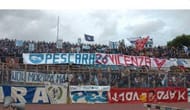
When the brilliance of Bruno Nobili and Giorgio Ripetto won them their first ever promotion to the Serie A in 1977, Pescara Calcio had finally entered the big bad world of Italian football. The team was already a household name to the followers of the game in Italy, for something that had happened a few months earlier.
When 3,000 traveling Delfini, as the Pescara fans are more popularly known, went to Vicenza Calcio’s Stadio Romeo Menti for a Serie B match, few expected the attention to divert from a young Paolo Rossi, the lynchpin of the home club and future Azzurri legend. However, neither Rossi nor his teammates could prevent Pescara from winning the crucial match.
In fact, so enthralling was the Pescara display, that the home fans stood up and applauded the winners, a gesture that was magnanimously replicated in the return leg. In an incredible season, the two teams finished at the top and managed to qualify for Serie A, with their friendship lasting ever since. “Nessuno Ci Separa” is the binding motto between the clubs – “Nothing separates us”.
Most importantly, the twinning and ever-lasting friendships of rival fans, known in the local tongue as Gemellaggio, had been born.
#9 Atalanta and Ternana
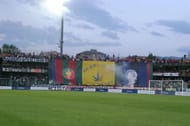
Few clubs in Italy are as politically oriented or controversial as Ternana. The Stadio Libero Liberati outfit has some of the most passionate and vociferous crowds in the country. Like the name of their home and their much-publicized relationship with Livorno, the capital of Italian communism would suggest Ternana has always been an anti-establishment club.
Nothing showed this side of the Rossoverdi more than their infamous marijuana tifo, which was displayed during a Serie B match against Atalanta in 2005. However, their choice of neither the occasion nor the opposition was a coincidence. It was a result of their association with one of Italy’s main feeder clubs, Atalanta.
A member of the Curva Nord, known for its fascist outlook except in the case of Atalanta, the club’s friendship with Ternana is an ideological paradox, wholly dependent on their mutual hatred of Brescia and Perugia respectively. However, its true extent could be seen from a 2003 Serie B clash.
When Ternana took the lead after a questionable penalty in the 87th minute, the game was going only one way. However, their relationship with their rivals came to the fore, as they allowed Igor Budan to equalize unchallenged. Why the match went uninvestigated during the Calciopoli saga, is a million-dollar question.
#8 Parma and Empoli
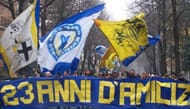
Right from their days of ignominy to the Parmalat takeover to European glory and now back to ignominy, Parma’s bond with Empoli has been one that has stood the test of time. The fact that the Boys Parma, one of Italy’s most notorious Ultra factions have been on such amicable terms with the rival fans of a club, is a testament to the gemellaggi the two teams enjoy.
It all started on a cold evening in 1984 during a Serie B tie when the Parmensi travelled to the Stadio Carlo Castellini to face Empoli. After the end of 90 hugely foggy minutes, Empoli emerged as winners, a result that was lost on their supporters due to the inclement weather. This is when the Parma fans showed a touch of class by going to their opposition’s Curva Sud stands to inform them of the results.
A close alliance has existed between the fans ever since, with the 2013/14’s return Serie A fixture seeing the 30th anniversary of the friendship. More occasions for celebrations need a miracle, however, with the sorry state of Parma right now.
#7 AC Milan and Brescia
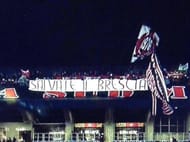
“Cori per il Brescia e contro L’Atalanta!”
”Choirs for Brescia and against Atalanta!” sang the Milan fans in November 2011, a season where Brescia was absent after being relegated earlier that year. Their illustrious friends, however, nearly won the Scudetto, before losing to eternal rivals Juventus.
The amicizia between AC Milan and Brescia is a peculiar one in many ways; on one hand, you have two teams twinning from the same region (Lombardy). This is rarely seen anywhere else in the world, as proximity generally spews hatred. On the other hand, the friendship also stands out because of the relationship between the Curva Nord Ultras of Brescia and the Curva Sud Ultra groups of Milan.
When a young, naive Demetrio Albertini gave Milan the lead against Brescia in a win-or-die match for the latter in May 1993, there was silent consternation against the midfielder across the stadium. Even though Milan “allowed” Brescia to equalize in two minutes time, it was too late for them, as relegation came beckoning. Needless to say, Brescia’s hated rivals Atalanta rejoiced; after all, Brescia had been vanquished by their twin club.
#6 Palermo and Padova

Currently in liquidation and wilderness, Calcio Padova was a force to be reckoned with once upon a time. The Biancoscudati last played in the Serie A two decades back and are in a sorry state today. But, back in their heydays during the 1980s, the Patavini had some of the scariest Ultras in the country.
Coming from the predominantly anti-South and pro-right wing province of Veneta, the club from Padua were one of the flagbearers of the Northern Ultras back in the day. And this is exactly why their friendship with a Sicilian club, probably the southernmost in the country, is such a curious twist of fate.
The Curva Nord Ultras of Palermo were a heterogeneous bunch, with Palermitani groups being set up in Rome, Lombardy, Emilio-Romagna etc. During the 1980s, the Rosaneri Ultras, clad in all pink, terrorized fans who used to visit the Stadio Renza Barbera. But then, all that changed when a group of fans from Padua came for a Sicilian summer holiday.
An acquaintance with the Palermo Ultras that was born out of that trip went on to become a full-blown case of Gemellaggio, as the clubs maintained their relations during their next tie in 1983, and have done so ever since.
#5 Sampdoria and Bari
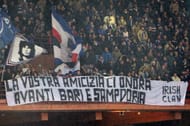
Lenin. Jim Morrison. Alex DeLarge, of A Clockwork Orange fame. These are all historical and pop-culture icons, who hold a special place in the heart of one of Italy’s most controversial fans, the Ultras Titos Cucchiaroni of Sampdoria. Famous for their hostile treatment of rival fans, they were the trailblazers of the Ultra movement in Italy in the 1960s. With the Derby Della Lanterna, arguably Italy’s most underrated derby pitting them against Genoa, the Sampdoria fans know to put on a show, and how.
Famous for their pyrotechnics and flare shows, the 58,000 strong home of Bari is equally intimidating, if not more. However, both groups of Ultras have now shared an official “twinship” for nearly a decade now. It all started on a fine afternoon in Cremona about a decade ago when the Ultras of Bari held aloft a banner calling out the Cucchiaroni Ultras in a cry of solidarity.
The Stadio Luigi Ferraris witnessed a moment of camaraderie a few weeks later, when the Sampdoria fans returned the favour, making their Amicizia with the Bari Ultras official.
#4 Fiorentina and Hellas Verona

Another club with whom Sampdoria shares a close bond, Hellas Verona has a set of Ultras steeped in the culture of not just the team, but also the ancient city of Verona. The Brigate Gialloblu Ultras of Verona are immensely proud of their coat of arms, and proudly proclaim “against hypocrisy and compromise – we hate everybody”.
Fiorentina is an exception though. The fiercely anti-Juventus and anti-Bologna inhabitants of Stadio Artemio Franchi give no quarters and take no nonsense – Mohammed Salah looks set to be the latest victim of their furious anger. The Ultras Viola, who are the Florentian guardians of “Campanilisimo” or patriotism, are however on amicable terms with their equally volatile counterparts from Verona.
A strongly apolitical outfit, Fiorentina’s relationship with the predominantly fascist Hellas fans, has been a long standing one. With a mass exodus of players from the violet jerseys to the yellow ones in the early to mid 1980s, Hellas Verona won their first and only Scudetto, with a team consisting of a number of former Viola men, including their star man, Antonio Di Gennaro.
#3 Napoli and Genoa

The oldest Gemellaggio existing in Serie A today, Napoli and Genoa share an attachment that transcends geography, history and politics. It all started with a season-ending fixture featuring the two teams in 1982, when Genoa needed a point against the Neapolitans to stay in the Serie A.
Napoli, who shared a fierce rivalry with AC Milan at the time, knew that a Genoa draw would enable the latter to go through at the expense of the Rossoneri. A 2-2 stalemate was played out, much to the delight of either fans, as both parties got what they wanted. Another instance followed, exactly a quarter of a decade later, as both teams played out a drab, goalless draw to qualify for the Serie A.
The Rossoblu then greeted the traveling fans with a grand tifo saying, “Welcome back, Neapolitan brothers!”. Napoli fans too returned the adulation with some pre-match chanting, thus ensuring the football was played in high, yet good spirits. In fact, Stadio San Paolo and Stadio Luigi Ferraris have both witnessed wonderful instances of mutual respect and brotherhood every time the two teams have played.
#2 Lazio and Inter Milan
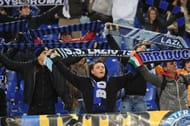
If Milan is the fashionable face of Italian football, Rome is its violent underbelly; the villain. The visceral nature of football in the Eternal City is perfectly encapsulated in the Derby Della Capitale pitting Lazio and Roma. A club that takes pride in its fascist origins and beliefs, Lazio has arguably the most fearsome Ultra group in Italy – the Irrudicibili, the “Unbreakables”.
Gorgeous choreography, intense intimidation and unshakeable faith are the hallmarks of the Irrudicibili. And this is exactly why they loved the likes of Paul Gascoigne and their very own son Paolo Di Canio, football’s staunchest right-wing supporter. And in the “Boys-San” of Internazionale, the Ultras of Rome have among the strongest and most powerful friends in Italy.
Holding extremist sentiments themselves, the Ultras of the blue half of Milan, are capable of putting up a spectacle like no other. And when the Irrudicibili was founded in the 1980s, a long-lasting friendship was formed.
This was never more evident than in the 1998 UEFA Cup final, when the two teams met at the Parc-Des Princes in Paris. Both sets of fans rejoiced and celebrated together in a glorious advertisement for football, as a Ronaldo inspired Nerazzurri went on to win the title.
#1 Juventus, ADO Den Haag and Legia Warszawa
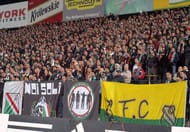
Juventus has one of the largest away fan bases among all Italian clubs. However, it is a very, very cosmopolitan following, and not something bred out of geography or ideology. And in a country that demands loyalty and commands identity, this sets the Bianconeri apart – and not in a good way.
The fact that they do not have an official Gemellaggio with any Italian club is as much a result of this phenomenon, as it is of their rivals’ sour-grape mentality like they love to suggest. And this, as much as anything else, is one of the reasons why the Turin club are called “La Fidanzata d’Italia” – The Girlfriend of Italy.
However, La Vecchia Signora shares a strong bond with the Polish giants Legia Warszawa and the Eredivisie club, ADO Den Haag. With the former being highly anti-Communist and the latter being notoriously anti-Semitic, the relationship of Juventus with the two clubs is highly frowned upon in certain Bianconeri circles.
However, their relationship is here to stay, with the Dutch team’s website succinctly putting it as “Don’t be surprised to hear a Polish or an Italian chorus at the Kyocera Stadion”.
